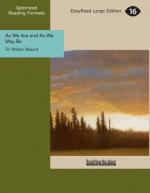orders, and for exactly the same reason, because at
the original foundations of the colleges, as well
as of the Hospital, the Fellows were all priests.
As for the Master, he remained a layman. This
new order of things, therefore, raised the position
of the Brothers, and gave a new dignity to the Hospital;
further, the School as well as the Bedeswomen defined
its position as a charity. It still fell far,
very far, short of what it might have done, but it
was not between the years 1698 and 1825 quite so useless
as it had been. A plan of the Precinct, with
drawings of the church, within and without, and of
the monuments in the church, may be found in Lysons.
The obscurity of the Hospital, and the neglect into
which it fell during the last century, are shown by
the small attention paid to it in the books on London
of the last century, and the early years of the present
century. Thus, in Harrison’s ‘History
of London,’ though nearly every church in the
City and its immediate suburbs is figured, St. Katherine’s
is not drawn. In Strype (edition 1720) there
is no drawing of St. Katherine’s; in Dodsley’s
‘London,’ 1761, it is described but not
figured; and Wilkinson, in his ‘Londina Illustrata,’
passes it over entirely. The Hospital buildings
consisted of a square, of which the north side was
occupied by the Master’s house, with a large
garden behind, and the Master’s orchard between
his garden and the river; on the east and west sides
were the Brothers’ houses; and on the south side
of the square was the church and the chapter-house.
On the east of the church was the burying-ground.
South of the church was the Sisters’ close,
with the houses occupied by the Sisters and the Bedeswomen.
The old Brothers’ houses were taken down and
rebuilt about the year 1755, and the Master’s
house, an ancient building, full of carved timber-work,
had also been taken down, so that in the year 1825,
when the Hospital was finally destroyed, the only
venerable building standing in the Precinct was the
church itself. To look at the drawings of this
old church and to think of the loving care with which
it would have been treated had it been allowed to
stand till this day, and then to consider the ‘Gothic’
edifice in Regent’s Park, is indeed saddening.
The church consisted of the nave and chancel with two
aisles, built by Bishop Beckington, formerly the Master.
The east window, 30 feet high and 25 feet wide, had
once been most beautiful when its windows were stained.
The tracery was still fine; a St. Katherine’s
wheel occupied the highest part, and beneath it was
a rose; but none of the windows had preserved their
painted glass, so that the general effect of the interior
must have been cold. The carved wood of the stalls
and the great pulpit, presented by Sir Julius Caesar,
may still be seen in the Regent’s Park Chapel,
where are also some of the monuments. Of these
the church was full. The finest (now in Regent’s
Park) was that of John Holland, Duke of Exeter, and




